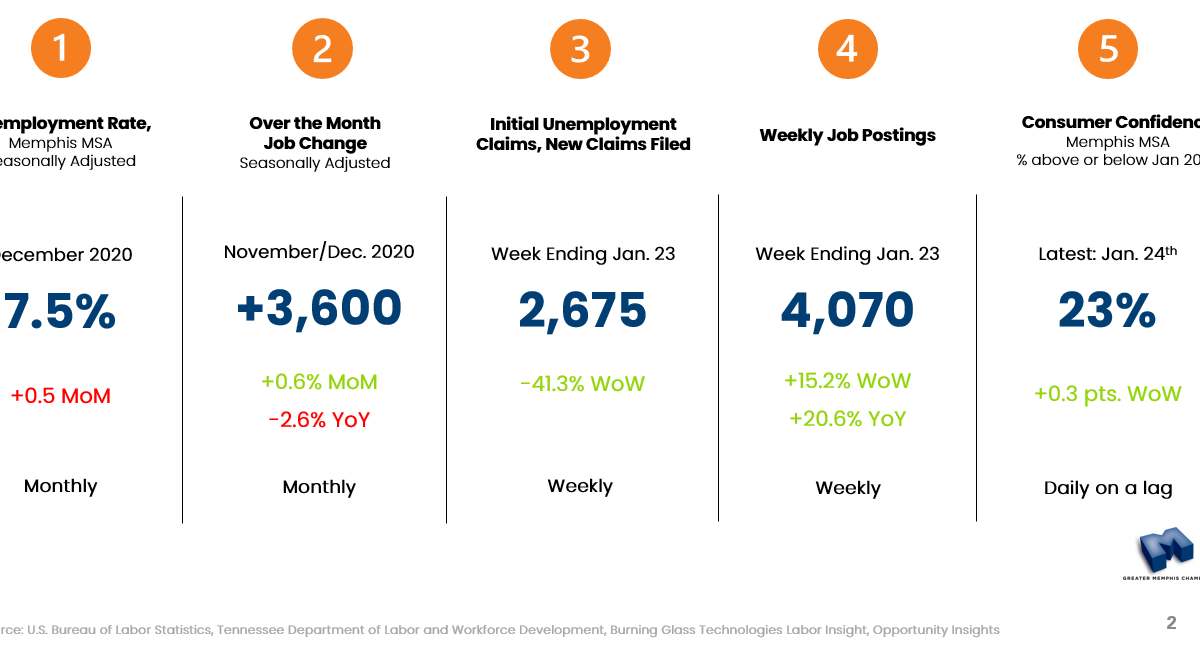
February 8, 2021 – To build an understanding of the current market trends that are impacting the Memphis Metro area, the Chamber has been releasing monthly updates to our economic recovery.
To best gauge and position insights related to market activity, we are looking at the region through two lenses. The first is through the lens of traditional monthly indicators. These measures include the lower frequency jobs and unemployment figures and are often seen as lagging indicators of labor market activity. The second lens is through higher frequency weekly indicators. These measures include weekly unemployment insurance claims and job postings. Often, the higher frequency indicators are seen as leading indicators and can signal worsening or better employment outcomes for the region against the monthly reports.
With the release of the December 2020 unemployment numbers on February 3, these updates will provide a key snapshot of where the Memphis market sits as it relates to a recovery from the March/April 2020 contraction.
The Greater Memphis Chamber develops insights that help stakeholders ask the right questions to issues impacting our region’s economic competitiveness. To understand the impact of COVID in the current economic environment, the team analyzes data using a combination of sources such as the Bureau of Labor and Statistics as well as cutting-edge tools such as Burning Glass Labor Insights and EMSI, the Chamber aims to provide stakeholders with information that can help drive prosperity for all in the region.
{{cta(‘8b2652cc-425f-4fc2-91f3-d7cb450b6936’)}}
Indicators to Watch

Key insights from this report:
- Monthly Indicators, [lower frequency, lagging indicators]
- December 2020, the seasonally adjusted unemployment rate in the Greater Memphis MSA rose 0.5-points to 7.5%. This follows larger dynamics within the State of Tennessee, where the unemployment rate increased from 5.2% to 6.4% from November to December 2020. The next release for (January 2020) metropolitan estimates will be March 19, 2021.
- Non-farm payrolls (jobs) in the Memphis metropolitan area increased by a seasonally adjusted 3,600 from November to December 2020, a month-over-month increase of 0.6%.
- The market has regained 73% of jobs lost March to April 2020. The region remains 3% below March 2020 and ranks well among a competitive set of metropolitan areas.
- If the region were to add jobs back at a rate consistent with its most recent 3-month moving average, a return to March 2020 job levels could occur mid to late summer, sooner if job growth accelerates at a rate consistent with leading competitive markets.
- Weekly Indicators, [higher frequency, leading indicators]
-
- The early weeks of January 2021 saw increases in the number of individuals filing for initial and continued unemployment insurance claims. While still elevated above year-end levels, initial claims fell 41% week-over-week with continued claims rising 4% week-over-week.
- Online job postings, a proxy for employer demand have stabilized against historical levels. This is reassuring, as employers rebound and stabilize against new workplace dynamics. While indicative of demand, jobseekers should leverage skills for in-demand occupations within new industries. Week ending January 23, 2021 was 20.6% higher than this same week in 2020.
- While the Greater Memphis market holds relatively high unemployment, many employers continue to hire. Broad based occupational groups are in demand in key areas including: Logistics and Supply Chain Support, Office Support and Customer Care, Healthcare, and Accommodation and Food Services.
- Consumer Spending, a proxy for consumer optimism, is the amount of money spent by households in an economy for durable and nondurable goods and services. Shown below, after sharp decelerations through the month of March, levels of spending continue to show signs of volatility. As of week-ending Jan. 24, spending was 23% above January 2020. This growth is primarily support by Retail, Grocery, and Health Care spending.
- The early weeks of January 2021 saw increases in the number of individuals filing for initial and continued unemployment insurance claims. While still elevated above year-end levels, initial claims fell 41% week-over-week with continued claims rising 4% week-over-week.
{{cta(‘8b2652cc-425f-4fc2-91f3-d7cb450b6936’)}}
Questions? We would love to hear from you! Click here to send a question or request media access.


